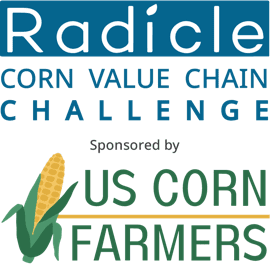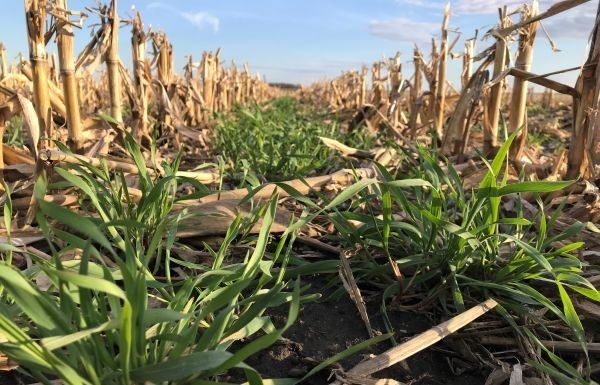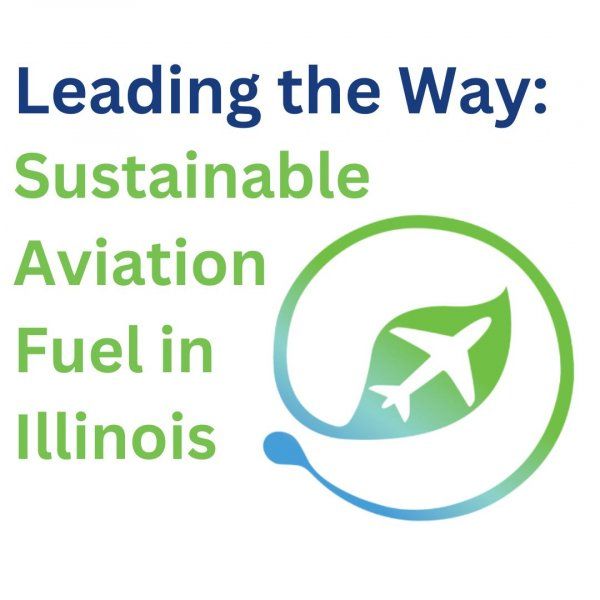Featured Article

February 29, 2024
The search is on for AgTech, Chemical, or Material Start-ups and Growth Companies worldwide whose innovative technologies and business models create new uses for corn and long-term sustainable demand for corn production. San Diego, February 29th, 2024 –Radicle Growth, a company-building platform investing in early-stage agriculture and food technologies, is delighted to announce, "The Radicle Corn Value Chain Challenge sponsored by US Corn Farmers." The Challenge sets out to invest a minimum of US $1.5M in start-up and growth companies from around the world whose innovative technologies and business models create new uses for corn and long-term sustainable demand for corn production. These companies are expected to be developing new uses of corn that result in replacements for fossil fuel-derived materials with plant-derived materials such as sustainable aviation fuels (SAF), drop-in chemicals and plastics, compostable materials, and as yet unidentified products and product categories that could be new areas for corn-derived products to be used. "Illinois farm family profitability is a concern that is top of mind for IL Corn. Through the Radicle Corn Value Chain Challenge, we have the opportunity to explore new uses for our corn and develop the market demand that will ensure long-term profitability for all U.S. corn farmers and will contribute to the economic growth of our country,” said Jon Rosenstiel, IL Corn Marketing Board Chairman and farmer from Pearl City. Corn is grown on nearly 100 million acres in the United States. Approximately 48% of corn production is used for animal feed, 30% is used for biofuels, and 22% is for exports and other uses. Corn production is typically responsible for more than $80B of annual value in the United States. Corn farmers across the Midwest produce the bulk of that corn, assuring the vitality of rural communities and driving this economy, and agricultural and downstream market trends are impacting that growth engine. In addition to new demand from new uses, more sustainable corn production systems overall will enhance the demand for any new bio-product in a highly competitive marketplace. With the continuing revolution in AI, biotechnology, and new business models throughout the corn value chain, we anticipate identifying companies able to modify the corn crop, biological and thermochemical processing of the corn crop, high-value health applications, sustainable fuels, and sustainable bioproducts. “Driving new demand for U.S. corn is a top priority for NCGA and its state partners,” said Harold Wolle, National Corn Growers Association president. “We’re proud to partner with supporting states on this innovative challenge as another way NCGA is working to find new uses for corn and provide sustainable product solutions for consumers.” Kirk Haney, Managing Partner of Radicle Growth, said: "Feeding and providing plant-based materials for our growing population is paramount. We recognize that to transform our agriculture system and advance solutions in the food and industrial value chains sustainably, we need to find new technologies working to create new uses for corn. We are excited about the opportunity to benefit US corn farmers by finding and funding the best entrepreneurs worldwide who solve these issues." A minimum of US $1.5 million investment will be made in The Radicle Corn Value Chain Challenge to one or more winners to accelerate their growth. Apply now. Investment decisions will be made during a "Pitch Day" in the Fall of 2024. A judging panel of industry experts will hear from 4 finalists who will be chosen from the global applicant pool. In addition to the funding, the winners will also get access to advice from both corn industry experts and Radicle senior executives to help accelerate their company's business and technical efforts. About the IL Corn Marketing Board The IL Corn Marketing Board was established in 1982 to manage the voluntary checkoff investment that corn farmers in the state agreed to implement that year. The farmers that serve on the board are elected by their peers to serve unpaid three-year terms. These ICMB farmer leaders strategically invest Illinois corn checkoff dollars to grow demand, create new markets, and foster understanding of corn farmers and the corn industry, which is Illinois’ highest valued agricultural commodity. Find out more about ICMB at www.ilcorn.org and the family farmers who contribute to the checkoff at www.watchusgrow.org . Media Contact : Lindsay Croke lcroke@ilcorn.org About NCGA: Founded in 1957, the National Corn Growers Association represents nearly 40,000 dues-paying corn farmers nationwide and the interests of more than 300,000 growers who contribute through corn checkoff programs in their states. NCGA and its 50 affiliated state organizations work together to create and increase opportunities for corn growers. Media Contact : Bryan Goodman goodman@ncga.com About Radicle Growth: Radicle Growth selects innovative, early-stage companies for investment, ensuring that disruptive AgTech & Food Tech companies reach their full potential. In addition to providing seed-stage capital, Radicle Growth provides a fertile environment for visionaries in the ag and food space to flourish. Their proprietary platform is one of a kind in the ag and food industry, filling a huge void in the market by identifying the most innovative technologies and accelerating them with a range of value-creation initiatives. To connect and learn more about Radicle Growth follow us on LinkedIn , Twitter and Instagram . To stay informed on Radicle Challenges, visit: https://radicle.vc/the-radicle-challenge/ . Media & Investor Relations Contact: Damaris Mozo dmozo@radicle.vc

February 23, 2024
America is in pursuit of a clean energy future, but to get there, our leaders must prioritize a solution that already exists at gas stations across the country. Ethanol , made from corn produced on farms in Illinois and throughout the heartland, is a low-cost, low-carbon fuel resulting in up to 52% fewer harmful tailpipe and greenhouse gas emissions than regular gasoline. Today, nearly every gallon of gasoline in the U.S. contains at least 10 percent ethanol, but by expanding the marketplace with higher blends, policymakers can help decarbonize the transportation sector while continuing to offer drivers a choice at the car dealership and the gas pump. What’s more, they can bolster the financial viability of farming operations and safeguard the resources Americans rely on each day. Today, family farmers throughout the country face economic hardships as high inflation is causing the cost of producing crops to be more expensive than ever before. In Illinois specifically, crop budgets for 2024 include a reduction in the corn and soybean prices , resulting in negative return and lower profitability projections for farmers in all regions of the state. This takes away from the income farmers rely on to pay their bills, educate their children and invest in their communities. According to the American Farm Bureau Federation , America’s farmers can expect net farm income this year to be $40 billion lower than in 2023 – that’s a 25 percent reduction and the largest recorded year-to-year dollar drop. Transitioning away from renewable fuels and exclusively to electric vehicles (EVs) as proposed by the Environmental Protection Agency last year would only create more hardships for America’s farmers. Ultimately, this transition would decrease the price of corn and cost the agriculture industry an estimated one-billion bushels of corn in the next decade. In fact, if the price of corn permanently decreases by 50 percent, the top five corn-producing states – Iowa, Illinois, Nebraska, Minnesota and Indiana – could collectively lose more than $100 billion in farmland value . Yet the impact would not just be felt by farmers, but all of rural America as rural businesses that rely on a viable agricultural sector and rural schools that rely on property taxes would lose critical funding. It’s clear now more than ever that to meet our nation’s emissions reductions goals, policymakers must take a broader approach to EVs and harness the full benefits of corn-based ethanol. The first step they can take is passing the Next Generation Fuels Act , bipartisan legislation that would expand ethanol usage and create a path for the production of more advanced, efficient vehicles that run on low-carbon fuels. Corn farmers are doing their part to advance America’s clean energy future, now it’s time for our leaders to support them in making it a reality.

February 22, 2024
This week, Illinois state lawmakers tried hitting the gas to incorporate California’s extreme vehicle emissions standards into the Midwest. HB1634 allows California to govern Illinois Vehicle Code and would essentially require: 35% of new light duty vehicles including cars, SUV’s and pick-up trucks sold must be electric by 2026. By 2035, 100% must be electric. Mandates that 75% of all new heavy- duty truck sales and 40% of class 7 and 8 tractor sales must be zero emission by 2035. Requires new trucks sold to be zero emission starting in 2036. Requires used trucks owned by medium and large fleets also be zero emission by 2042. “We cannot allow another state the power to regulate Illinois,” IL Corn Growers Association President Dave Rylander said. “If passed, this bill would have drastic impacts on our farming, trucking and transportation industries. Not only would it hurt our state citizens today, but it would open the door for more aggressive regulations without our consent in the future.” The IL Corn Growers Association was present in Springfield as the Illinois House Energy and Environment Committee cancelled the bill’s hearing Tuesday following adamant opposition. Over 3,700 opposition slips were filed against the bill. ICGA sent a letter to the committee outlining the proposed legislation’s dangerous precedent and unrealistic implications. Adopting California emissions standards would allow another state to govern Illinoisans and significantly increase the cost of vehicles. An average electric vehicle costs approximately $10,000 more than its gasoline-powered counterpart. California emissions standards substantially increased gas and diesel prices for the state. Gas prices in California average $4.65 compared to Illinois’s $3.50. Similarly, diesel is $1.30 more in California than current Illinois prices. Additionally, Illinois’s charging infrastructure and climate are different from the west coast state. Illinois is millions of dollars behind California’s electric charging availability. As seen in early 2024, battery electric vehicles do not perform well in cold climates. Although the hearing was cancelled last week, the legislation is still active. Fill out the Call 2 Action below notifying your state representative and senators we need to Put the BRAKES on HB1634 and its Senate companion. Sign up to ICGA’s C2A platform to voice your concern with HB1634.

February 15, 2024
Seven members of Illinois’s congressional delegation joined a group of 43 lawmakers in a letter to the Sustainable Aviation Fuels Lifecycle Analysis Interagency Working Group voicing their support for biofuels and the Department Energy’s Argonne GREET Model. Senators Richard Durbin, Tammy Duckworth and Representatives Nikki Budzinski (D-13), Robin Kelly (D-2), Darrin LaHood (R-16) Mike Bost (R-12) and Eric Sorensen (D-17) signed the bipartisan, bicameral letter urging the group to finalize updates to the model by the March 1 deadline. “As you continue to develop a model to determine eligibility, we ask that you take measures to permit every participant in the SAF lifecycle to appropriately participate in the carbon reduction process,” the letter said. This message serves as a follow up to the Treasury’s 40B SAF tax credit guidance on eligibility released in December and urges the working group to adopt an updated GREET model to their methodology. The SAF tax credit was included in the Inflation Reduction Act (IRA) and states SAF will qualify for a standalone blenders credit (40B) if the fuel reduces lifecycle greenhouse gas emissions by at least 50 percent. IL Corn thanks our members for their support of GREET Model and Illinois corn farmers.

February 15, 2024
The U.S. Department of Agriculture’s (USDA) National Agricultural Statistics Service (NASS) announced the results of the 2022 Census of Agriculture, spanning more than 6 million data points about America’s farms and ranches and the people who operate them, down to the county level. Here are Key Summary Points: There were 71,123 farms and ranches in Illinois during 2022, down 2% from five years ago. The average farm size was 370 acres, down 2 acres from the previous Census of Agriculture in 2017. Illinois remained the #1 state for soybeans, horseradish, and pumpkin acres There were more than 33,000 farms that grew soybeans in Illinois during 2022. Nearly 650 farms grew pumpkins in Illinois, and more than 68% of those acres were harvested for processing. 50 Illinois farms grew more than 2,000 acres of horseradish in 2022. Illinois was #2 in corn acres, #3 in total crop sales, and #4 in hog inventory. Illinois farms and ranches produced $26.4 billion in agricultural products, up 55% from the $17.0 billion that was produced in 2017. Farm production expenses totaled $17.8 billion. That is up 33% from 2017. The top 5 counties by total farm sales are Iroquois, McLean, Livingston, LaSalle and Champaign The top 5 counties by Average Sales/Farm are Gallatin, Lawrence, Logan, DeKalb and Piatt In terms of demographics: The average age of all Illinois producers was 58.6, up from 58.0 in 2017. 33,927 female producers accounted for 28.0% of all Illinois producers. The number of Illinois farmers and ranchers under age 35 was 10,632, and that was 8.8% of all IL producers. Lastly but not least, cover crop acres totaled 881,228 in 2022 and that is up 24% from 2017. Despite a decrease in acres overall, National Agricultural Statistics Service Illinois State Statistician Mark Schleusener said farmers, except for those in the west, fared well throughout the state. “I think one of the surprising things for 2022 was the combination of good yields and good prices in Illinois,” he said. “Usually, we don't get the two together. If there's a production problem, the price is usually high, and if production is good the price is usually low. But, because of a series of complicated factors, Illinois farmers were blessed with the good weather and the good prices.” Listen to the latest episode of IL Corn TV on Monday for a deeper dive into the census with Schleusener! Listen to Audio here:

February 15, 2024
This is the best February since last February. That’s because, like this time last year, my beloved Kansas City Chiefs won the Super Bowl. Like millions of Americans, I was glued to the television during the recent game. While some members of my family love to talk and engage in Monday-morning quarterbacking during football games (my Mom even paces), I tend to watch silently and intently, assessing every strategic move the Chiefs and their opponents make. Strategy is critical to winning; whether it’s football games or the work my team and I do every day on the political field that is the nation’s capital. Just as a coach looks at old plays of the opposing team, we look at all the potential plays that could be used by the various interests in Washington as we work to advance the policies that are important to corn growers. And, boy, do we have our work cut out for us this year, as there are enough moving parts and unprecedented events to make even Andy Reid and Travis Kelce run for the hills. One of our major goals is to get a comprehensive farm bill, which includes our priorities, through both chambers of Congress and signed by the president before the current expiration in September. We also want to advance the Next Generation Fuels Act; extend consumer access to E15 through the summer months; and see the U.S. hold trading partners accountable to their commitments. To accomplish these goals, we must navigate a Congress that not only has deep inter-party divisions but also increasingly fierce intra-party disagreements. The intense disagreements between Democrats and Republicans have helped fuel delays in the government funding bills. Ideally, these would have been signed into law before the Oct. 1, 2023, fiscal year began. Instead, a stopgap was approved that punted funding for four government agencies (including the U.S. Department of Agriculture) to March 1 and eight other agencies to March 8. Congress must clear the deck on government funding before they will be able to move onto the farm bill and other corn grower priorities. Leaders in the Senate and House have agreed to a $1.66 trillion government funding framework, but the details of how the money will be allocated will continue to be a challenge. Supplemental funding legislation for Ukraine, Israel and Taiwan has further exposed intra-party disagreements within the Republican Party. As of this writing, the Republicans in the Senate joined their Democratic counterparts to pass $95 billion in supplemental foreign funding. But Speaker Mike Johnson (R-La.) has said the legislation will go nowhere unless funding for border security is included in the bill. To put an exclamation point on all of this, the House voted to impeach Homeland Security Secretary Alejandro Mayorkas. The last time a cabinet member was impeached was 1876. These are certainly not ordinary times. But corn growers are no ordinary group. We fight. We make our case and, like the Chiefs, we play to win. While there is a lot at stake in Congress, we are also focused on the Administration where we’re watching rulemakings important to the future of the ethanol industry and seeking science-based standards with our trading partners. For example, we recently organized an effort to send a letter to President Biden cautioning him against prioritizing electric vehicles over biofuels, such as corn ethanol. The letter comes on the heels of a similar effort by auto dealers and as the administration has advanced rulemakings in multiple agencies which favor zero emission vehicles. The effort resulted in major media coverage . We also continue to fight to eliminate trade barriers, such as the Mexican ban on biotech corn, and efforts to place and maintain tariffs on products, like fertilizers, that are widely used by farmers. These are just a few of the many examples of the ways in which we keep the ball moving on our pressing issues. And despite the many challenges in Congress, we plan to clear the field and win. So, when people ask me how corn growers deal with the challenges that we are hit with on what has become a regular basis, my response is always the same: We shake it off. Appleton is vice president of public policy at the National Corn Growers Association. The IL Corn Growers Association is a member of the National Corn Growers Association.

February 15, 2024
It’s a day some of us may dread or love but IL Corn took this as a chance to partner with another ag company to spread the love. “Prairie State Tractor caught my attention with their innovative and engaging content on Tik Tok which made me reach out to collaborate on this lovely holiday,” said Tara Desmond Marketing & Communications Manager at IL Corn. After some brainstorming, IL Corn & Prairie State Tractor landed on cute and funny corny pick up lines but we also find it fun to educate farmers and non-farmers on the connections to corn and farming on this holiday. Watch this short video:

February 14, 2024
BLOOMINGTON, Ill. – IL Corn is pleased to announce the inaugural Sustainable Aviation Fuel (SAF) conference uniting the state’s stakeholders in the airline, manufacturing , government and agricultural industries.The Illinois Sustainable Aviation Fuel Conference will be held on March 21-22. The event follows the enactment of the first state SAF purchaser credit in June 2023 . “The intersection of Illinois’s robust agriculture industry, aviation hub, and unique tax incentives gives our state a prime location to lead the world in SAF use and production,” IL Corn Growers Association Director, farmer and pilot Chris Gould said. “The event is only the beginning of what Illinois will offer in this sector.”
Articles
2025
2024
2023
2022
2021
2020

